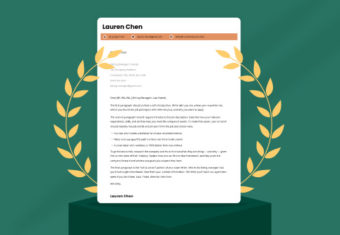Not all open job positions are advertised publicly. Sometimes, it pays off to make the first move and reach out to companies that you’d like to work for, even if they don’t have any job listings on LinkedIn.
That’s where a letter of intent comes in.
What is a letter of intent?
A letter of intent (LOI) is used to reach out to a company you’re interested in applying to, but that isn’t currently advertising any open positions that match your experience.
It typically includes information about your professional background, greatest accomplishments, and an explanation of why you’d be a great fit for the company.
In many ways, a letter of intent is similar to a cover letter, with the difference that a cover letter is submitted along with a resume to respond to a job ad.
Not sure what exactly a cover letter is? A cover letter is almost always paired with your resume to highlight your accomplishments and passion for the role. Make sure you know how to write one before you apply for jobs.
Why should you write an intent letter?
Like a letter or statement of interest, a letter of intent for employment purposes lets you introduce yourself to the employer so they’ll keep you in mind in case any positions open up in the future.
It’s a great way to show employers that you’re a proactive person who takes initiative, both qualities that are highly sought after.
Not only that, but writing a letter of intent shows that you’re passionate about the role.
You can also use your letter of intent to request an informational interview and learn more about the company.
Sample letter of intent for a job
Before we get into how you write a letter of intent, here’s an example to show you what they look like:
Tips for writing a letter of intent
Writing a letter of intent for a job can be tricky because it needs to be compelling enough that your name sticks in the employer’s mind. Here are three tips to follow to make the writing process easier:
1. Express interest in the company
The first paragraph should make it clear why you’re writing a letter of intent, but also why you’re writing to that particular company. The more specific you are, the better.
Here are some topics you can bring up in your intent letter to prove that you’re passionate about the company:
- Mention a product the company produces that you like and why
- Talk about the organization’s goals and explain how you could help them achieve them
- Refer to the company’s mission statement and discuss why it resonates with you
- Describe recent company developments and how you’d be able to contribute to the organization’s continued success
By including details about the company in your letter of intent, you show that you’ve done your research and aren’t sending out identical letters to several other businesses.
2. Quantify your achievements
An effective letter of intent showcases your most impressive accomplishments to give the employer a glimpse at what you could achieve working for them.
To make your letter even more impactful, quantify your achievements using hard numbers like you would if you were writing a resume.
Compare these two examples written by a financial advisor:
Bad example
In my last role, I devised and applied a new training and accountability program that successfully increased productivity.
Good example
In my last role, I devised and applied a new training and accountability program that successfully increased productivity by 18% in 12 months.
The second example is better because it describes exactly how successful the new training and accountability program was.
3. Highlight your skills
In addition to spotlighting your achievements, you should use your letter of intent to prove that you have the skills required to succeed at the company.
You can do this by listing skills relevant to the type of position you want to be considered for. For example, if you’re a graphic designer, make sure to draw attention to photo editing software you’re proficient with and your ability to come up with creative designs.
There’s no need to include an exhaustive list of skills you possess, just mention a few that will (hopefully) make the employer curious enough about your qualifications that they’ll respond to your letter.
4. End with a call to action
Conclude your letter of intent with a call to action that encourages the employer to contact you. This demonstrates that you’re eager to get started as soon as possible and increases your likelihood of receiving a response.
Letter of intent for employment template
Here’s a template for you to copy so you can easily write your own letter of intent for a job:
[Dear Hiring Manager],
Paragraph 1: Write a few sentences explaining why you’re interested in the company. Tell a story about how you found out about the organization, or explain why you’ve been following recent developments at the company.
- Write 2-4 bullet points highlighting your relevant accomplishments
- [Accomplishment 2]
- [Accomplishment 3]
Paragraph 2: Use this paragraph to describe your skill set. Remember to focus on abilities that the employer could benefit from.
Paragraph 3: End your letter of intent with a call to action. Include your phone number and email so that the employer can reach out to you.
Sincerely,
[Your Name]
Click to rate this article
4.7 Average rating















